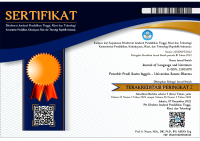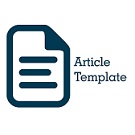Hyperbole in Indonesian Song Lyrics
(1) (SCOPUS ID: 57283936200) Universitas Gadjah Mada
(*) Corresponding Author
Abstract
Language is pivotal in fulfilling human communicative needs, such as transactional and interactional functions. In the latter function, language is employed, one of which is to build social and personal attitudes, or so-called poetic or imaginative function. Such functions can be accessed through songs or song lyrics. Motivated by the previous argument, this paper aims to describe construction types and categories of hyperbolic expressions found in various Indonesian song lyrics, comprising the genres of “kroncong,” “dangdut,” and other popular songs. To provide the evidence, this study collected data from YouTube and carefully examined how the song lyrics involve hyperbolic expressions. The analysis also comprised identifying the types of hyperbolic expressions in terms of their linguistic constructions. Analysis reveals that hyperbole is constructed in either positive or negative sentences, metaphors, superlative, and serial adjectival constructions. Those hyperbolic expressions can at least be classified into five categories, i.e. quantity hyperbole, quality hyperbole, distance hyperbole, time hyperbole, space hyperbole, and action hyperbole. These categories seem to closely relate to the scope of human perceptions about everything they find in the world. They will always have associations with number, state, distance, time, space, and actions anyone can perform. This study concludes the intertwined relationship between language and human behaviors.
Keywords
Full Text:
PDFReferences
Ardiantari, I A.P.G., Andriyani, A.A.A.D. & Swabawa, I B.M.S. Discourse Analysis on Jiwa yang Bersedih. Lire Journal (Journal of Linguistics and Literature), 7(2), 290-300. https//doi.org/10/33019/lire v.7i2.227
Brown, G. & Yule G. (1983). Discourse Analysis. Cambridge University Press.
Buhler, K. (1933). “Die Axtiomatik der Sprachwissenschaaft”. Kant-Studient, 38, 19-90. Berlin Hall
Dardjowidjojo, S. (2009). Lirik dari Keroncong ke Dangdut: Cermin Perubahan Budaya. In Subagyo, P.A. & Sudartomo, M. (Eds.), Peneroka Hakikat Bahasa. Universitas Sanata Dharma.
Halliday, M.A.K. (1975). Learning How to Mean: Explorations in the Development of Language. Edward Arnold.
Hardjoprawiro, K. (2006). Bahasa di dalam Terjemahan. UNS Press.
Hornby, A.S. (2015). Oxford Advanced Learner’s Dictionary. Oxford University Press.
Jakobson, R. (1996). Linguistik dan Bahasa Puitik. In Sudjiman P. & Van Zoest, A. (Eds.) Serba-serbi Semiotika. Gramedia Pustaka Utama.
Kridalaksana, H. (1993). Kamus Linguistik. Edisi ke-3. Gramedia Pustaka Utama.
Leksono, N. (2014). Ismail Marzuki: Senandung Melintas Zaman. Kompas.
Putra, E.E. & Hamzah, H. (2021). Comparative Analysis of Language Style between Song Lyrics of English and Indonesian Pop Singers. FBSN Padang.
Pradopo, R.D. (2021). Pengkajian Puisi. Cetakan ke-13. Gadjah Mada University Press.
Siregar, B.U. (2011). Seluk-Beluk Fungsi Bahasa. Pusat Kajian Bahasa dan Budaya. Universitas Katolik Indonesia Atma Jaya.
Soegono, D., Sugiono & Qodratillah, M. (2014). Kamus Besar Bahasa Indonesia. Edisi ke-4. Gramedia Pustaka Utama.
Suharto, S. (2004). Music and Language: A Stress Analysis of English of English Song Lyrics. Harmonia, 5(3)
Ulya, M., Fadlilah, U. & Raficoh, M. (2021). An analysis of Language Style in the Song Lyrics of “Manusia Kuat” by Tulus: A stylistic Study. Lintang Songo, 4(2)
Verdonk, P. (2002). Stylistics. Oxford University Press.
Wijana, I D.P. (2018). Aneka Fungsi Bahasa Syair-syair Lagu Ismail Marzuki. Deskripsi Bahasa, 1(2).
Wijana, I D.P. (2022). Human Hopelessness as Thematic Device in Indonesian Song Lyrics. Linguistic Issues: A Compilation of Working Papers. TS Publisher.
Yosa, R. (2016). Metafora Wanita pada Lagu-lagu Ismail Marzuki (Undergraduate Thesis). Universitas Gadjah Mada.
DOI: https://doi.org/10.24071/joll.v25i1.10316
Refbacks
- There are currently no refbacks.

This work is licensed under a Creative Commons Attribution-ShareAlike 4.0 International License.
Journal of Language and Literature (JOLL) is published by Prodi Sastra Inggris, Fakultas Sastra, Universitas Sanata Dharma.
JOLL is indexed in:

This journal is is licensed under a Creative Commons Attribution-ShareAlike 4.0 International License












